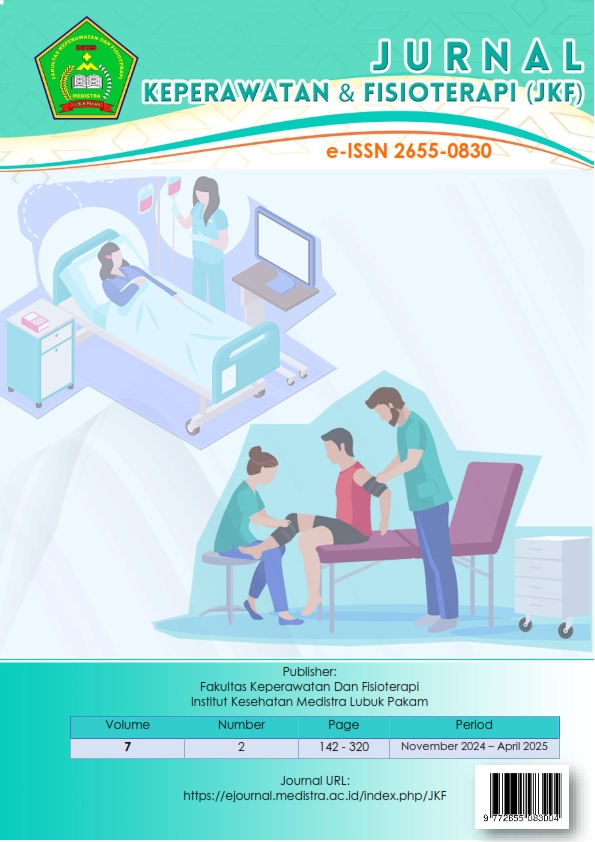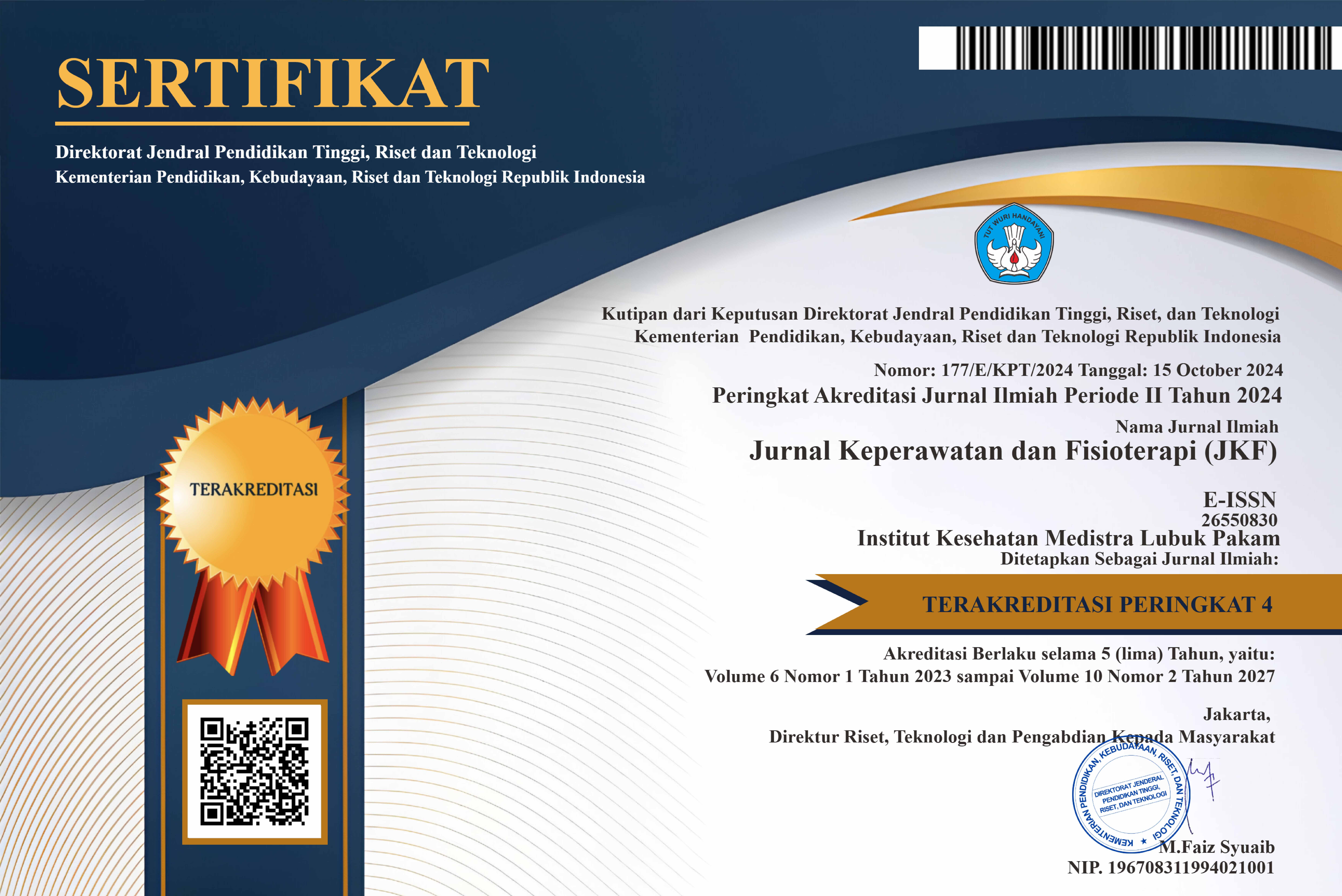The Relationship Between Training Frequency and Tennis Elbow Injuries in Tennis Players
DOI:
https://doi.org/10.35451/jkf.v7i2.2614Abstract
Tennis is a sport that uses rackets and can be played by two or four players. Forehand, backhand, and serve shots are some of the methods used to hit the ball while playing tennis. Constantly hitting the ball with a racket can strain the hand, increasing the risk of tennis elbow injury. Because it often affects tennis players, the term “tennis elbow” is used. To succeed and excel, an athlete must exercise and have optimal body shape. A combination of the three elements of exercise duration, frequency, and intensity is necessary to obtain training results. Training methods, specifically training frequency, intensity and duration, have a significant impact on player health. Biomechanical movements and high weekly training frequency make athletes vulnerable to injury, one of the diseases that often affect tennis players is tennis elbow. The purpose of this study was to ascertain the relationship between training frequency and tennis elbow injuries experienced by tennis players. Observational analytic research design and quantitative methods were used in this study. The approach used was cross-sectional research. A purposive sample approach, which considers many factors, was used to select 27 tennis players in Malang City who became the study population. In this study, training frequency is the independent variable and tennis elbow injury is the dependent variable. In this study, Cozen's test and questionnaire were used to evaluate tennis elbow. Using Spearman's test for statistical testing, a P value of 0.381 was found. In this case, the p value was greater than ? (0.05). The conclusion of this study is that there is no relationship between training frequency and tennis elbow injury.
Downloads
References
Andini, E. A., & Indra, E. N. (2020). Perbedaan Pengaruh Frekuensi Latihan Senam Aerobik Terhadap Penurunan Persentase Lemak Tubuh Dan Berat Badan Pada Members Wanita. Medikapora, 50, 39–52.
Diantono, K., & Indardi, N. (2022). Hubungan Frekuensi Latihan Dengan Hasil Ketepatan Mendarat Atlet Paralayang Jawa Tengah Pada Kejuaraan Pon Xx Papua. 02, 27–31.
Evita, Y. (2020). Analisis Gerak Forehand Tenis Lapangan Pada Rafael Nadal. Journal Unesa.
Fannani, W., Ma’rufa, siti ainun, & Riyati, indras catur setyo. (2023). Efektivitas Trasverse Friction Terhadap Penurunan Nyeri Pada Tennis. 2(8), 532–537.
Firdaus, M. N., Marisa, D., & Asnawati. (2019). Hubungan Frekuensi Dan Lama Latihan Terhadap Kelenturan Otot Penari Modern. 2(1), 73–80.
Herliyana, F., & Rahman, I. (2021). Penatalaksanaan Fisioterapi Pada Kasus Tennis Elbow Dextra Dengan Modalitas Ultrasound Dan Hold Relax Di Rs Pindad Kota Bandung. 4(2), 37–43.
Jariono, G., Warthadi, A. N., Sistiasih, V. S., & Hernawan, B. (2024). Optimalisasi Pemahaman Pemanasan dan Pendinginan untuk Mencegah Cedera pada Klub Olahraga. Abhipraya, 1(2), 1–7.
Kim, J., & Yoon, J. H. (2021). Does obesity affect the severity of exercise-induced muscle injury? Journal of Obesity and Metabolic Syndrome, 30(2), 132–140. https://doi.org/10.7570/JOMES20100
Koesoemadhipura, D. O., & Wijayanti, A. P. (2021). Penatalaksanaan Fisioterapi Pada Tennis Elbow Dextra Dengan Modalitas Ultrasound Dan Terapi Latihan Dengan Hold Relaxe. Jurnal Kesehatan Tambusai, 2(4), 152–158.
Maulana, M. R. D., Martaviano, B. S. T., & Setiawan, W. (2019). Analisis Pola Pantulan Bola Tenis Berdasarkan Variasi Ketegangan Senar Raket. 3–6.
Murtafiah, Zahra, N. A., Susilo, T. E., & Pristianto, A. (2022). Manajemen Fisioterapi pada Gangguan Fungsional Tangan Penyintas Tennis elbow Tipe 2?: Case Report. Physio Journal, 2.
Nabila, Q., Putri, dinda permata, Payonga, umbu simon, Hidayatullah, S., & Chamidah, ika niswatul. (2023). Edukasi Penanganan Pertama Cedera Olahraga Pada Anggota PMR SMPN 5 Malang. Jurnal Pengabdian Ilmu Kesehatan (JPIKes), 3(3).
Prayuda, B. A. (2016). Pengaruh Latihan Rope Jump Selama 20 Detik Dengan Metode Interval Training 1?: 5 Terhadap Kecepatan Gerak Lari. 06(2).
Puspitasari, N. (2019). Faktor Kondisi Fisik Terhadap Resiko Cedera Olahraga Pada Pemain Sepakbola. Jurnal Fisioterapi Dan Rehabilitasi (JFR), 3(1), 54–71.
Rahim, A. F., Safira, F., & Rosidah, N. (2023). Hubungan Kekuatan Core Stability Dengan Risiko Pemain Tenis Lapangan Di Kota Malang. Jurnal Kesehatan Tambusai, 4, 5736–5740.
Sunaryadi, Y. (2017). Kontribusi Segmen-Segmen Tubuh Terhadap Kekuatan Servis Dalam Permainan Tenis. 89–98.
Tandiyo, D. K. (2014). Penatalaksanaan Kedokteran Fisik dan Rehabilitasi Tennis Elbow. 41(5), 385–388.
Tarigan, F. D., & Supriadi, A. (2021). Pengembangan Alat Latihan Ketepatan Sasaran Forehand Drive Padacabang Olahraga Tenis Lapangan Tahun 2021. Journal Physical Health Recreation, 2(November), 62–68.
Wahyudi, muhammad fajar, Siregar, ahmad yani, Ginting, M., Sianturi, tri yuyanti, Alfarizi, R., Nurkadri, & Siregar, mustika wati. (2024). Tenis Dan Kesehatan?: Manfaat Fisik Dan Mental Dari Bermain Tenis. Jurnal Ilmiah Kajian Multidisipliner, 8(10), 80–82.
Wibowo, eko trisno, & Hakim, A. A. (2018). Profil Indeks Massa Tubuh Pada Atlet Tim Nasional Indonesia Pada Asian Games 2018. Jurnal Kesehatan Olahraga, 08(01), 131–140.
Downloads
Published
Issue
Section
License
Copyright (c) 2025 Felix Nashar Novanto, Anita Faradilla Rahim, Dimas Sondang Irawan

This work is licensed under a Creative Commons Attribution 4.0 International License.
Copyright in each article is the property of the Author.


























